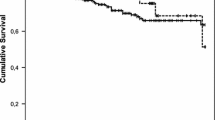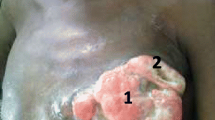Abstract
Purpose
The objective of the study is to investigate what kind of tumors young, premenopausal breast cancer patients in Germany show at diagnosis and how they are treated adjuvantly in comparison with a normally distributed cohort.
Methods
The study describes the data of 535 patients who were treated adjuvantly between 2002 and 2006 and participated in a resident mother–child program for rehabilitation (Groemitz cohort). The data includes TNM categories, biology of tumor and therapies. This population is being compared to an age-heterogeneous cohort from the state of Schleswig-Holstein and the DMP-report of the state of North Rhine-Westphalia.
Results
45.8 % of the patients were diagnosed with tumor category pT1, 37 % pT2, 7.3 % pT3 and 1.9 % pT4. 5 % had merely DCIS. 48.8 % of the patients were pN0, 31.4 % pN1 and 17.4 % had a more intense manifestation of lymph nodes. 43.5 % of the tumors showed a grading classified as G3, 64.3 % were estrogen and progesterone hormone receptor positive and 26.2 % Her2 positive. 21 % of the examined cohort members/patients showed a triple negative carcinoma. 59.1 % of the patients with pT1 underwent breast-conserving surgery, 56.1 % of those with pT2 and 25.6 % of those with pT3. Overall 31.0 % of the women received mastectomy and 14.8 % received mastectomy with subsequent reconstruction. 97.6 % of the patients received axillary surgery, 89.9 % chemotherapy. Overall 23.7 % of the patients received their treatment in connection with clinical studies. 95.3 % of the patients with hormone receptor positive tumor received endocrine therapy, 61.3 % of them with GnRH-analogs. In comparison with the OVIS and DMP cohorts patients of the Groemitz cohort were on average 20 years younger. Their tumors were of bigger size and had more often reached the axillary lymph nodes (pN0 48.8 % Groemitz/62.0 % OVIS/66.7 % DMP). The hormone receptor status was more often negative (35.7/16.6/16.5 %) and tumor grading higher (G3 43.5/29.0/28.5 %). Surgery was more extensive even with small tumors (breast conserving surgery with tumor stage pT1 59.1/81.2/77.6 %) and axillary surgery was performed more often in the young collective (97.6/89.3/62.5 %). More patients of the young collective received chemotherapy (89.9/58.4 %/unknown) and more patients of the young collective with hormone receptor positive tumor received endocrine therapy (95.3/77.4/90.6 %).
Conclusion
Our study shows that young breast cancer patients in Germany can be regarded as a special group. At the time of diagnosis the tumor has frequently reached a more advanced stage, and carcinomas are more aggressive. Operative and medical treatment will often be more aggressive.
Similar content being viewed by others
References
Katalinic A, Rawal R (2008) Decline in breast cancer incidence after decrease in utilisation of hormone replacement therapy. Breast Cancer Res Treat 107:427–430
Katalinic A, Lemmer A, Zawinell A, Rawal R, Waldmann A (2009) Trends in hormone therapy and breast cancer incidence—results from the German Network of Cancer Registries. Pathobiology 76:90–97
DeMichele A, Putt M, Zhang Y, Glick JH, Norman S (2003) Older age predicts a decline in adjuvant chemotherapy recommendations for patients with breast carcinoma: evidence from a tertiary care cohort of chemotherapy-eligible patients. Cancer 97:2150–2159
Kosiak B, Sangl J, Correa-de-Araujo R (2006) Quality of health care: what do we know? Womens health Issues 16:89–99
Waldmann A, Pritzkuleit R, Raspe H, Katalinic A (2008) Guideline-compatible treatment of breast cancer patients. Dtsch Ärztebl Int 105(18):337–343
(2009) Disease-management-programme in Nordrhein Qualitätsbericht 2009. http://www.kvno.de/downloads/quali/qualbe_dmp09.pdf
Robles-Castillo J, Ruvalcaba-Limon E, Maffuz A, Rodriguez-Cuevas S (2011) Breast cancer in Mexican women under 40. Ginecol Obstet Mex 79(8):482–488
Kheirelseid EH, Boggs JM, Curran C, Glynn RW, Dooley C, Sweeney KJ, Kerin MJ (2011) Younger age as a prognostic indicator in breast cancer: a cohort study. BMC Cancer 11:283
Tarone RE (2006) Breast cancer trends among young women in the United States. Epidemiology 17(5):588–590
Gonzales-Angulo AM, Broglio K, Kau SW, Eralp Y, Erlichman J, Valero V, Theriault R, Booser D, Buzdar AU, Hortobagyi GN, Arun B (2005) Women age < or = 35 years with primary breast carcinoma: disease features at presentation. Cancer 103(12):2466–2472
Rapiti E, Fioretta G, Verkooijen HM, Vlastos G, Schäfer P, Sappino AP, Kurtz J, Neyroud-caspar I, Bouchardy C (2005) Survival of young and older breast cancer patients in Geneva from 1990 to 2001. Eur J Cancer 41(10):1446–1452
Love RR, Duc NB, Dinh NV, Quy TT, Xin Y, Havighurst TC (2002) Young age as an adverse prognostic factor in premenopausal women with operable breast cancer. Clin Breast cancer 2(4):294–298
Elkum N, Dermime S, Ajarim D, Al-Zahrani A, Alsayed A, Tulbah A, Al Malik O, Alshabanah M, Ezzat A, Al-Tweigeri T (2007) Being 40 or younger is an independent risk factor for relapse in operable breast cancer patients: the Saudi Arabia experience. BMC Cancer 7:222
Loibl S, Amant F, Kaufmann M, Ring A, Han S, Giermek J, Fehm T, Bontenbal M, Heinrigs M, Lenhard M, Scherr I, Mehta K, von Minckwitz G (2010) Patients with breast cancer during pregnancy-results from a prospective and retrospective registry (GBG20/BIG02-03). Cancer Res 70(24):S6–S12
El-Saghir NS, Seoud M, Khalil MK, Charafeddine M, Salem ZK, Geara FB, Shamseddine AI (2006) Effects of young age at presentation on survival in breast cancer. BMC Cancer 6:194
O‘Shaughnessy J, Osborne C, Pippen JE, Yoffe M, Patt D, Rocha C, Koo IC, Sherman BM, Bradley C (2011) Iniparib plus chemotherapy in metastatic triple-negative breast cancer. N Engl J Med 364(3):205–214
de Bock GH, van der Hage JA, Putter H, Bonnema J, Bartelink H, van de Velde CJ (2006) Isolated loco-regional recurrence of breast cancer is more common in young patients and following breast conserving therapy: long-term results of European Organisation for Research and Treatment of Cancer Studies. Eur J Cancer 42(3):351–356
Acknowledgments
We thank the “Klinik Ostseedeich” in Groemitz and especially Mrs Job for their cooperation.
Conflict of interest
We declare that we have no conflict of interest.
Author information
Authors and Affiliations
Corresponding author
Rights and permissions
About this article
Cite this article
Banz-Jansen, C., Heinrichs, A., Hedderich, M. et al. Characteristics and therapy of premenopausal patients with early-onset breast cancer in Germany. Arch Gynecol Obstet 286, 489–493 (2012). https://doi.org/10.1007/s00404-012-2291-9
Received:
Accepted:
Published:
Issue Date:
DOI: https://doi.org/10.1007/s00404-012-2291-9




